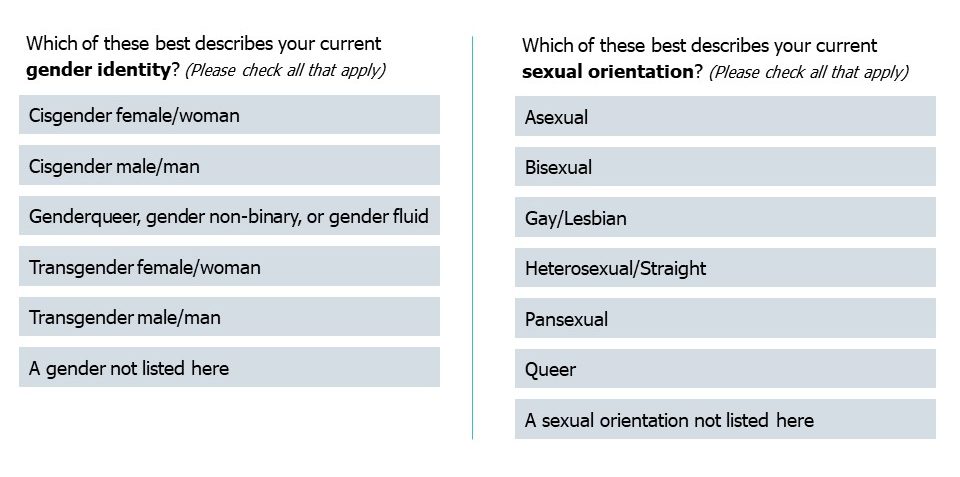

When asking questions about sex, sexual orientation, gender identity, and gender expression in surveys, it is important to understand the preferred terms and language to the best of our abilities. At Harder+Company, we prioritize cultural humility and embrace ongoing learning. We understand that language and word choice preferences evolve from year to year, from community to community, and from person to person.
A diversity of sexual and gender identities
The Gender Unicorn created by Trans Student Education Resources is one helpful way to think about the different dimensions of gender and sexuality.

In our survey work, the dimensions we address most often include:
- Biological Sex: medical assignment of “male,” “female,” or “intersex,” usually based on external anatomy at birth.
- Gender Identity: internal, deeply held sense of one’s own gender. Some people’s gender identity fits into traditional choices of “man” or “woman” and some people’s does not. Gender identity may or may not correspond to biological sex.
- Sexual Orientation: a person’s self-description of their physical, romantic, sexual, and/or emotional attractions.
As evaluators, our work most often leads us to shift away from the typical male/female survey response options focused on biological sex, distinguish between gender identity and sexual orientation, and recognize the full spectrum of both.
Using inclusive language
We are collaborating with We Breathe, a project of Health Access to evaluate a statewide initiative to reduce tobacco-related disparities in the lesbian, gay, bisexual, transgender, and queer (LGBTQ) communities. As part of this work, we developed a survey to collect data from members of the LGBTQ community who use or have used tobacco products, with the goal of identifying ways to prevent and reduce LGBTQ tobacco use. Since our audience are people who identify as LGTBQ, we thought very intentionally about the questions asking about gender identity and sexual orientation. We also worked with experts and the We Breathe Advisory Committee to ensure the wording of the survey questions reflected the most recent research. Here is the question wording we used in our survey:

- “Best describes” acknowledges that this list may not be perfect.
- “Current” acknowledges that gender and sexual orientation are not static and can change throughout someone’s life.
- “Please check all that apply” acknowledges that gender and sexual orientation can be multifaceted.
- “A gender not listed here” and “a sexual orientation not listed here” acknowledges this list is not inclusive and that someone who identifies as something we did not include should not be labeled as “other.”
Why you should collect sexual orientation and gender identity data
Respecting and embracing the full diversity of survey respondents allows researchers to better understand a community and recommend ways to respond to its needs. In recognition of this, some states require the collection of sexual orientation and gender identity data by law. In California, for instance, the AB-959 Lesbian, Gay, Bisexual, and Transgender Disparities Reduction Act requires the state departments of health care services, public health, social services, and aging to collect this data. The bill highlights the importance of gathering this information so public policy can better address LGBTQ health disparities.
Collecting data is crucial to supporting development of culturally appropriate interventions and track improvements in community health for the achievement of health equity. LGBTQ communities have historically been excluded from data collection, hiding and often worsening disparities. Inclusive, appropriately-worded survey questions are the first step to normalizing the diversity of sexual and gender identities and collecting data that can effectively inform critical programs and services.
————
To learn more about creating visibility for the LGBTQ community, and why and how you should collect data on sexual orientation and gender identity, check out this resource from the California LGBTQ Health and Human Services Network.
